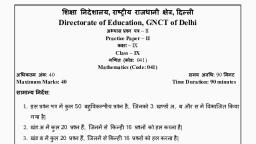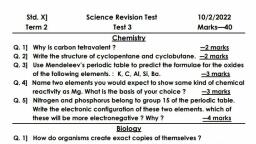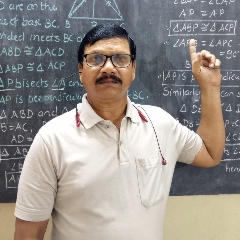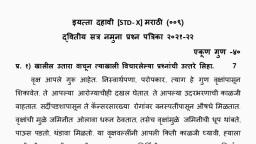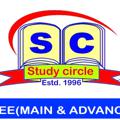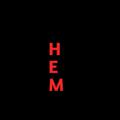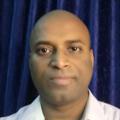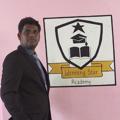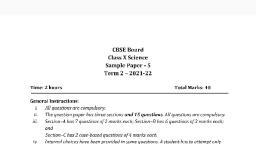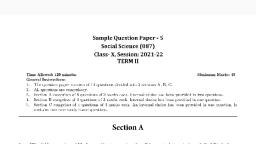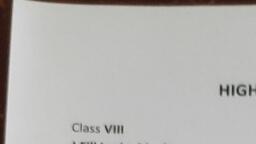Question 3 :
When white light enters a prism, its gets splits into its constituent colours. This is because of:<br/>
Question 5 :
The path of beam of light becomes _____ in a colloidal solution.
Question 7 :
At sun rise of sunset, the sun looks more red than at mid-day because
Question 9 :
Assertion: Incoming light reflected by earth is partially polarized.
Reason: Atmospheric particle polarize the light.
Question 11 :
Which of the following phenomena cannot be explained by scattering of light ?
Question 12 :
When is the direction of scattered light independent of the wavelength?
Question 13 :
Larger particles scatter light at the ____ end of the spectrum the least. <br/>
Question 15 :
A person is wearing spectacles with concave lenses for correcting vision. While not using the glasses, the image of a distant object in his case will be formed<br>
Question 17 :
No matter how far you stand from a mirror, your image appears erect. The mirror is likely to be<br>
Question 18 :
The focal length of convex lens is 30 cm and the size of image is quarter of the object, then the object distance is:-
Question 19 :
The image formed by the given convex mirror when it is inside focal distance is:
Question 20 :
"Value of refractive index remains same for light rays with different wavelength and for a particular material"
Question 21 :
The frequency of a light wave in a material is $2\times 10^{14} Hz$ and wavelength is $5000\overset {\circ}{A}$. The refractive index of material will be :
Question 22 :
The relation between the linear magnification $m,$ the object distance $u$ and the focal length $f$ is
Question 23 :
A short sighted person can see distinctly only those objects which lie between $10cm$ and $100cm$ from him, The power of the spectacle lens required to see a distance object is
Question 24 :
If a $3cm$ tall object placed perpendicular to principal axis of a convex lens of focal length $15cm$ produces a real invented image of height $15cm$, then its object distance $(u)$ is ................ and image distance $(v)$ is ................
Question 25 :
A ray of light coming parallel to the principal axis after passing through a convex lens, has passed through its :
Question 26 :
No matter where the object is placed in front of a mirror, the image formed is virtual, erect and smaller than the object. This mirror must be:
Question 27 :
What is the power of the lens, if the far point of a short sighted eye is $200\ cm$?
Question 28 :
Which of the following is not a characteristic of image formed by Concave lens ?
Question 29 :
If the refractive index of medium $b$ with respect to medium $a$ and that of medium $c$ with respect to medium b are given, then the refractive index of a medium $c$ with respect to a medium $a$ can be found by using the relation<br/>$n_{ca}\, =\, n_{ba}\, \times\, ........$<br/><br/>
Question 30 :
The power of a lens having a focal length of $1\;cm$ is :
Question 31 :
Four students perform an experiment on tracing the path of a ray of light passing through a rectangular glass slab. Their individual observations are:<br>identify the incorrect observation and correct them.<br>
Question 32 :
A man sees a smallstationary fish deep in a very clear lake and shoots it accurately. He will
Question 34 :
A concave lens forms the image of an object which is :<br><br>
Question 35 :
When light goes from a denser to a rarer medium the angle of refraction is:
Question 36 :
The power of a lens is negative. State whether it is convex or concave?<br/>
Question 38 :
When light is refracted from a surface, which of its following physical parameters does not change?
Question 39 :
The constant ratio of the sine of angle of incidence to the sine of angle of refraction is also known as:
Question 41 :
During refraction through a glass block, the angle of refraction _______.
Question 42 :
Which of the following is not an application of convex lens?
Question 44 :
Height of the image of an object on an principal axis produced by a convex lens is double the focal length of lens is $20 cm$, then image distance from the lens is:
Question 45 :
A convex lens is used to form real image of an object on a screen. It is observed that even when the positions of the object and that screen are fixed are two position of the lens to form real images. If the heights of the images are $4\ cm$ and $9\ cm$ respectively the height of the object is
Question 47 :
A focal length of a lens is 10 cm. What is power of a lens in dioptre?
Question 48 :
Due to refraction, sunrise appears ______ sun comes to horizon and sunset appears______sun leaves horizon respectively.
Question 49 :
The focal length of a combination of lenses formed with lenses having powers of $+2.50\ D$ and $-3.75\ D$ will be
Question 50 :
When a ray of light passes through a rectangular glass slab, the angle of emergence
Question 53 :
State whether the following statement is True or False.A concave mirror always forms a real image
Question 54 :
The image of an object formed by a device isalways virtual and small. The device may be
Question 55 :
On the basis of their experiment, "To trace the path of a ray of light through a rectangular glass slab," students of a class arrived at which one of the following conclusions :
Question 57 :
State whether true or false : A concave lens will always give a virtual, erect and diminished image.
Question 60 :
If an object is placed at '$C$' of a concave mirror, the position of the image is ______
Question 62 :
What is the power of a concave lens of focal length50 cm?
Question 63 :
In passing through a boundary, refraction will not take place if
Question 66 :
A man is unable to see closer than 1 m clearly.The power of lenses of his spectacles should be to see nearby object.
Question 68 :
A glass concave lens is placed in a liquid in which it behaves like a convergent lens. If the refractive indices of glass and liquid with with respect to air are $_a{\mu}_g$ and $_a{\mu}l$ respectively, then
Question 69 :
The expression for the magnification of a spherical mirror in the terms of focal length (f) and the distance of the object from mirror (u) is
Question 70 :
The sun subtends an angle of $(1/2)^o$ at earth.The image of the sun is obtained on a screen using a converging lens of focal length 1.5 cm.The diameter of the image will be :
Question 71 :
Images formed by which of the following arrangement isnot Virtual and erect ?
Question 72 :
The flat face of a plano-convex lens of focal length $10$cm is silvered. A point source placed $30$cm in front of the curved surface will produce a.
Question 73 :
A man can see only between $75\ cm$ and $200\ cm$. The power of lens to correct the near point will be
Question 74 :
A convex lens produces a double size real image when an object is placed at a distance of $18$ cm from it. Where should the object be placed to produce a triple size real image?
Question 75 :
A ray of light travelling in air is incident on the plane of a transparent medium. The angle of incident is 45$^o$ and that of refraction is 30$^o$. Find the index of the medium.
Question 76 :
A ray of light strikes a glass plate at an angle of ${60}^{o}$. If the reflected and refracted rays are perpendicular to each other, the refractive index of glass is
Question 77 :
<p>One face of a rectangular glass plate$6{\text{ }}cm$ thick is silvered. An object held$8{\text{ }}cm$ in front of the fist face, forms an image$12{\text{ }}cm$ behind the silvered face. The refractive index of the glass is:</p>
Question 78 :
An object is placed at a distance of $f/2$ from a convex lens. The image will be
Question 79 :
For which of the following is $f > 0$:<br/><br/>I. Concave mirror<br/>II. Convex mirror<br/>III. Converging lens<br/> 
Question 80 :
When an object is moved along the principal axis of a thin converging lens of focal length 12 cm, two images, three times the size of the object are obtained when the object is at $x_1$ and $x_2$ distance from the lens. Which one of the following could be the value of the ratio $\frac {x_1}{x_2}$ ?
Question 81 :
A concave mirror is made from a hollow sphere of radius of curvature 30 cm.  If an object of height 2 cm is placed at 10 cm from the pole of the mirror, determine the size of the image :
Question 83 :
Calculate the magnification of an object if it is kept at a distance of $3 cm$ from a concave mirror of focal length $4 cm$:
Question 84 :
Assertion: Air bubble shines in water.
Reason: Air bubble in water shines due to refraction of light.
Question 85 :
A converging lens has a focal length of 100 cm.The power of this lens is
Question 86 :
Assertion: Light waves have different refractive indices in different media.
Reason: Variations in the velocities of light in different media cause the refractive indices to be different.
Question 87 :
After tracing the path of a ray of light passing through a rectangularglass slab for four different values of the angle of incidence, a studentreported his observations in tabular form as given below :<br><table class="wysiwyg-table"><tbody><tr><td><br>S.No</td><td><i</td><td><r</td><td>< e</td></tr><tr><td><br>I</td><td>${30^0}$</td><td>${19^0}$</td><td>${29^0}$<br></td></tr><tr><td>II</td><td>${40^0}$</td><td>${28^0}$</td><td>${40^0}$</td></tr><tr><td>III</td><td>${50^0}$</td><td>${36^0}$</td><td>${50^0}$</td></tr><tr><td>IV</td><td>${60^0}$</td><td>${40^0}$</td><td>${59^0}$</td></tr></tbody></table>The best observation is :
Question 88 :
A light ray travels from optically denser medium to optically rarer medium, if the angle of incidence and refraction at point of incidence are $\angle i$ and $\angle r$ respectively, then find the angle of deviation in terms of $\angle i$ and $\angle r$.
Question 89 :
A convex and a concave lens separated by distance $d$ are then put in contact. The focal length of the combination
Question 90 :
A ray of light travelling inside a rectangular glass block of refractive index $\sqrt 2$ is incident on the glass-air interface at an angle of incidence of $45^o$. The refractive index of air is one. Under the these conditions the ray will
Question 91 :
A ray of light is incident on glass slab making an angle of incidence $sin^{-1} \left( \dfrac{\sqrt 3}{2} \right )$. What will be the angle of refraction in glass of refractive index 1.5?
Question 92 :
Two lenses whose powers are $4D$ and $-2D$ are kept in contact. The power of the compound lens is:
Question 93 :
Let the $\mathrm{x}-\mathrm{y}$ plane be the boundary between two transparent media. Medium 1 in $\mathrm{z}\geq 0$ has a refractive index of $\sqrt{2}$ and medium 2 with $\mathrm{z}< 0$ has a refractive index of $\sqrt{3}$. A ray of light in medium 1 given by the vector $\vec{\mathrm{A}}=6\sqrt{3}\hat{\mathrm{i}}+8\sqrt{3}\hat{\mathrm{j}} + 10\hat{\mathrm{k}}$ is incident on the plane of separation. The angle of refraction in medium 2 is<br>
Question 95 :
If the angle of incidence is twice the angle of refraction in a medium of refractive index $\mu$, then the angle of incidence is :
Question 96 :
A glass slab has two long parallel faces. Light ray is incident on the glass slab and trace of light ray is drawn. Now glass slab is shifted parallel to the parallel faces. What will be the effect on the trace of light?
Question 97 :
The image of an object formed by a convex lens when the object is placed between the lens and the focal point is -
Question 98 :
The far point of a myopia eye is $1.5 m$. To correct this defect of the eye, the power of lens is _______.
Question 100 :
Sometimes blurred and less sharply defined images are formed. This defect is called
Question 101 :
The image formed by objective lens of compound telescope will be:
Question 102 :
Calculate the focal length of a convex lens of power 2D.<br/>
Question 103 :
A monochromatic ray of light enters a glass slab $\left( n=1.5 \right) $ along the normal to the surface. The angle of deviation of the refracted ray is:
Question 104 :
When light passes from one medium to another, the physical quantity that remains unchanged is
Question 105 :
Why does light bends while travelling from one medium to another?<br>
Question 107 :
If an object is placed at a distance of 20cm from the pole of a concave mirror, the magnification of its real image is 3. If the object is moved away from the mirror by 10cm, then the magnification is -1.
Question 108 :
A thin plane membrane separates hydrogen at27$^o$C from hydrogen at 127$^o$C, both being at thesame pressure. A plane sound wave enters from the cooler to the hotter side. If the angle of incidenceon the membrane is 30$^o$C, then the angle ofrefraction is <br>
Question 109 :
In optical instruments, the lenses are used to form image by the phenomenon of
Question 110 :
<p>An object placed $10 cm$ in front of a lens has an image $20<br>cm$ behind the lens. What is the power of the lens (In dioptre)?</p>
Question 111 :
State whether true or false :A concave lens is used as a magnifying glass
Question 112 :
An object 20 cm from a concave mirror form an image, double the size of the object, on a screen. How far should the screen be placed from the mirror? 
Question 113 :
A square wire of side $3.0 cm$ is placed $25 cm$ in front of a concave mirror of focal length $10  cm$, with its centre on the axis of the mirror and its plane normal to the axis. The area enclosed by the image of the wire is :<br/>
Question 115 :
Convex lens forms a real, point sized image at focus, the object is placed
Question 116 :
When an object is placed on the principal axis of a convex lens at two different positions, it produces the images with magnification +2 and -4 respectively. How many times more away from the lens the image will be formed in the second position as compared to the first position?<br>
Question 117 :
In vacuum, to travel distance 'd', light takes time 't' and in medium to travel distance $'5d'$, it takes time 'T'. The critical angle of the medium is.<br>
Question 118 :
The image obtained while finding the focal length of convex lens is...................
Question 119 :
When a light of wavelength $4000$ $\displaystyle \overset { \circ  }{ A } $ in vacuum travels through the same thickness in diamond and water separately, the difference in the number of waves is $200$. Find the thickness, if refractive indices of diamond and water are $\displaystyle \frac { 5 }{ 2 } $ and $\displaystyle \frac { 4 }{ 3 } $ respectively.
Question 120 :
A short linear object of length $b$ lies along the axis of a concave mirror of focal length $f$ at a distance $u$ from the pole of the mirror. The size of the image is approximately equal to:<br/>
Question 121 :
The glancing angle of incidence is $10^{\circ}$. What will be the glancing angle of reflection?
Question 122 :
A symmetric double convex lens is cut in two equal parts by a plane containing the principal axis. If the power of the original lens was 4 D, the power of a divided lens will be
Question 123 :
The final image in an astronomical telescope is _______ the original object . Fill in the gap.<br/>
Question 124 :
A water film is formed on a glass-block. A light ray is incident on water film from air at an angle of$\displaystyle { 60 }^{ \circ }$ with the normal. The angle of incidence on glass slab is<br>($\displaystyle { \mu }_{ g } = 1.5,{ \mu }_{ w } = \frac { 4 }{ 3 }$)
Question 125 :
Let the x-z plane be the boundary between two transparent media. Medium $1$ in $z\ge 0$ has a refractive index of $\sqrt { 2 } $ and medium $2$ with $z< 0$ has refractive index of $\sqrt { 3 } $. A ray of light in medium $1$ given by the vector $\vec { A } =6\sqrt { 3 } \hat { i } +8\sqrt { 3 } \hat { j } -10\hat { k } $ is incident on the plane of separation. The angle of refraction in medium $2$ is:
Question 126 :
A flim projector magnifies a flim of area $100 $ square centimeter on screen. If linear magnification is $4$ then area of magnified image on screen will be-
Question 127 :
A ray of light going towards the centre of curvature of a convex mirror ............
Question 128 :
Air has refractive index $1.0003$. Find the thickness of air column which will contain one more wavelength of yellow light of $6000$ $A^0$ than in same thickness of vacuum.
Question 129 :
The distance between an object and its doubly magnified image by a concave mirror is: [ Assume $f$ = focal length]
Question 130 :
The diameter of the reflecting surface of spherical mirror is called ..............
Question 131 :
The reflecting surface is given by $y = \dfrac{10L}{\pi} \sin \dfrac{\pi x}{5L}$. The co-ordinates of the point where a horizontal ray becomes vertical after reflection is:
Question 132 :
Three convex lenses are available having focal lengths of $4 cm, 40 cm$ and $4 m$ respectively. Which one could be used as magnifying glass?
Question 133 :
A concave shaving mirror has a radius of curvature of 35.0 cm. It is positioned so that the (upright) image of a mans face is 2.50 times the size of the face. How far is the mirror from the face?
Question 135 :
The focal length of a thin biconvex lens is 20 cm. when an object is moved from a distance of 25 cm in front of it to 50 cm, the magnification of its image changes from $m_{25}$ to $m_{50}$. The ratio of $m_{25}$ to $m_{50}$ is :
Question 136 :
A $4.5 cm$ needle is placed $12 cm$ away from a convex mirror of focal length $15 cm$. Find the location of the image and the magnification.
Question 137 :
What happens when a ray of light is made to fall on a mirror along the normal?<br/>
Question 138 :
The angle between the incident ray and the normal is called ________.<br>
Question 139 :
A spherical convex surface separates object and image space of refractive index $1$ and $4/3$ respectively. If radius of curvature of the surface s $0.1\ m$, its power is
Question 140 :
The magnitude of focal length of a concave mirror is $f$. An object is placed at a distance $x$ from the focus and forms a real image. The magnification is:<br/>
Question 141 :
A $2.5$ dioptre lens forms a virtual image which is $4$ times the object placed perpendicularly on the lens. Then the required distance of the object from the lens is .
Question 142 :
A short linear object of length $b$ lies along the axis of a concave mirror of focal length $f$ at a distance u from the pole of the mirror. The size of the image is approximately equal to :<br>
Question 143 :
Image of an object at infinity is formed by a convex lens of focal length $30 \ cm$ such that the size of the image is $2 \ cm$. If a concave lens of focal length $20\  cm$ is placed in between the convex lens and the image, at a distance $26\  cm$ from the convex lens, size of the new image is:
Question 144 :
A small object of linear dimension $x$ lies on the axis of an optical mirror of local length $f$ at a distance $a$ from mirror. The linear dimension of image:
Question 145 :
Aconvex lens of radii of curvature 20 cm and 30 cm respectively. It is silveredat the surface which has smaller radius of curvature. Then it will behave as $(\mu_g\, = \, 1.5)$
Question 146 :
In the table below, column I lists various mirrors  and lenses and column II their uses, qualities or properties.<br/><table class="wysiwyg-table"><tbody><tr><td>column  I</td><td>Column II</td></tr><tr><td>I. Plane mirror</td><td>A. Feels thinner in the middle.</td></tr><tr><td>II. Concave mirror</td><td>B. Always forms virtual image.</td></tr><tr><td>III. Convex mirror</td><td>C. Always forms virtual image of smaller size.</td></tr><tr><td>IV. Concave lens </td><td>D. Is used by dentists to examine teeth.</td></tr><tr><td>V. Convex lens</td><td>E. Can be used as reading glass.<br/></td></tr></tbody></table>The correct matching is:
Question 147 :
An object is placed at $30$ cm distance from a concave mirror of focal length $20$ cm, then nature, magnification of the image will be:
Question 148 :
Two thin lenses of power $+3.5D, -2D$ are placed in contact. Find the power of lens combination.
Question 149 :
An image of a bright square is obtained on a screen with the aid of a convergent lens. The distance between the square and the lens is $40\ cm$. The area of the image is nine times larger than that of the square. Select the correct statement(s).
Question 150 :
A point object is placed on the principal axis of the convex lens of focal length 20cm at a distance 40 cm to the left on it. The diameter of the lens is 10cm. If the eye is placed 60cm to the right of the lens at a distance h below the principal axis, then max value of 'h' to see the image is
